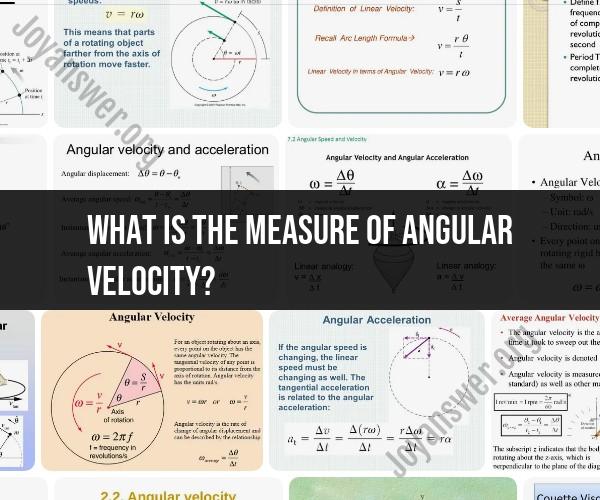What is the measure of angular velocity?
Angular velocity is a measure of how quickly an object is rotating or moving in a circular path. It represents the rate of change of angular displacement, which is the angle through which an object has rotated in a given time period. Angular velocity is typically denoted by the Greek letter omega (ω) and is measured in units such as radians per second (rad/s) or degrees per second (°/s).
The formula for angular velocity is:
Angular Velocity (ω) = Change in Angular Displacement (θ) / Change in Time (Δt)
Where:
- Angular Velocity (ω) is measured in rad/s or °/s.
- Change in Angular Displacement (θ) is the change in the angle the object has rotated through in radians (rad) or degrees (°).
- Change in Time (Δt) is the time interval over which the rotation occurs, measured in seconds (s).
Angular velocity can be positive or negative, depending on the direction of rotation. If an object is rotating counterclockwise (anticlockwise) when viewed from a specific vantage point, its angular velocity is positive. If it's rotating clockwise, the angular velocity is negative.
Angular velocity is an essential concept in physics and engineering, particularly in fields related to rotation, such as mechanics, fluid dynamics, and robotics. It's used to describe the rotational motion of objects and is often used in problems involving rotational dynamics and kinematics.
Exploring the Measure of Angular Velocity
Angular velocity is a measure of how fast an object is rotating. It is represented by the Greek letter omega (ω) and is measured in radians per second (rad/s). One radian is the angle between two radii of a circle when the arc length between the radii is equal to the radius of the circle.
Angular velocity can be calculated using the following equation:
ω = Δθ / Δt
where:
- ω is the angular velocity in rad/s
- Δθ is the change in angular displacement in radians
- Δt is the change in time in seconds
For example, if an object rotates through an angle of 30 degrees in 5 seconds, its angular velocity would be:
ω = 30° / 5 s = 6π/5 rad/s
How Angular Velocity Relates to Rotational Motion
Angular velocity is a fundamental concept in rotational motion. It is analogous to linear velocity in linear motion. Linear velocity is the rate of change of linear displacement, while angular velocity is the rate of change of angular displacement.
Angular velocity can be used to describe the rotational motion of any object, from a spinning top to a planet orbiting the sun. It is also used in many different applications, such as engineering, physics, and robotics.
Using Angular Velocity to Describe Circular Motion
Circular motion is a special type of rotational motion in which an object moves around a fixed axis in a circle. The angular velocity of an object in circular motion is constant.
The angular velocity of an object in circular motion can be calculated using the following equation:
ω = v / r
where:
- ω is the angular velocity in rad/s
- v is the linear velocity of the object in m/s
- r is the radius of the circle in m
For example, if an object moves around a circle with a radius of 1 meter at a linear velocity of 2 meters per second, its angular velocity would be:
ω = 2 m/s / 1 m = 2 rad/s
Angular Velocity and the Rate of Change in Angular Displacement
The rate of change of angular displacement is equal to the angular velocity. This means that the faster an object is rotating, the greater its angular velocity.
This can be expressed mathematically using the following equation:
dθ / dt = ω
where:
- dθ / dt is the rate of change of angular displacement in radians per second
- ω is the angular velocity in rad/s
Angular Velocity and Its Significance in Science and Engineering
Angular velocity is a very important concept in science and engineering. It is used in many different applications, such as:
- Physics: Angular velocity is used to describe the rotational motion of objects, such as planets, galaxies, and spacecraft.
- Engineering: Angular velocity is used to design and operate machines and devices, such as engines, turbines, and generators.
- Robotics: Angular velocity is used to control the movement of robots and other automated systems.
Overall, angular velocity is a fundamental concept in physics and engineering. It is used to describe and control the rotational motion of objects and devices.
Here are some additional examples of how angular velocity is used in the real world:
- The angular velocity of a car's wheel is used to determine the speed of the car.
- The angular velocity of a fan's blades is used to determine the amount of air that is circulated.
- The angular velocity of a helicopter's rotor is used to control the lift and thrust of the helicopter.
- The angular velocity of a gyroscope is used to maintain the orientation of a spacecraft.
Angular velocity is a very important concept in our modern world, and it has many applications in science, engineering, and everyday life.











